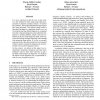Free Online Productivity Tools
i2Speak
i2Symbol
i2OCR
iTex2Img
iWeb2Print
iWeb2Shot
i2Type
iPdf2Split
iPdf2Merge
i2Bopomofo
i2Arabic
i2Style
i2Image
i2PDF
iLatex2Rtf
Sci2ools
IJCAI
2007
2007
Exploiting Independence in a Decentralised and Incremental Approach of Diagnosis
It is now well-known that the size of the model is the bottleneck when using model-based approaches to diagnose complex systems. To answer this problem, decentralized/distributed approaches have been proposed. The global system model is described through its component models as a set of automata and the global diagnosis is computed from the component diagnoses (also called local diagnoses). Another problem, which is far less considered, is the size of the diagnosis itself. However, it can also be huge enough, especially when dealing with uncertain observations. It is why we recently proposed to slice the observation flow into temporal windows and to compute the diagnosis in an incremental way from these diagnosis slices. In this context, we define in this paper two independence properties (transition and state independence) and we show their relevance to get a tractable representation of diagnosis. To illustrate the impact on the diagnosis size, experimental results on a toy example...
Artificial Intelligence | Complex Systems | Global Diagnosis | IJCAI 2007 | Model-based Approaches |
Related Content
| Added | 29 Oct 2010 |
| Updated | 29 Oct 2010 |
| Type | Conference |
| Year | 2007 |
| Where | IJCAI |
| Authors | Marie-Odile Cordier, Alban Grastien |
Comments (0)

